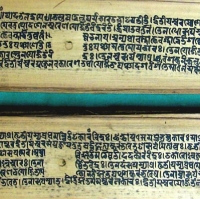This section is an overview of some of the most important textbooks used by Ayurvedic physicians.
 1. Charaka Samhita
1. Charaka Samhita
The Charaka Samhita is the oldest and most important Ayurvedic textbook, dealing primarily with internal medicine. It was originaly written about 2,500 years ago by Atreya Punarvasu, the devoted student of Bharadwaja, and later preserved and enlarged by the physician Charaka. It is very comprehensive, with sections on fundamental principles, diagnosis, dietetics, physiology, longevity and therapeutics.
2. Susruta Samhita
The Susruta Samhita was written by the physician Susruta at the time of the great conference circa 2,500 years ago. It is devoted to the field of surgery, but also contains very comprehensive information on each of the eight branches of Ayurveda, adding much new information not found in Charaka, such as treatment of eye diseases.
3. Harita Samhita
The Harita Samhita was written by the physician Harita at the same time as the Charaka Samhita and the Susruta Samhita. This book deals in internal medicine, is much smaller than either of those two. The existing copy was believed written in the 13th century CE, copied from earlier works.
4. Astanga Hridaya
The Astanga Hridaya was written by a Buddhist physician named Vagbhata circa 500-600 CE. This textbook deals primarily with therapeutics and adds some new herbs, new formulas and advanced information on the use of metals and minerals.
5. Astanga Sangraha
The Astanga Sangraha was also written by the Buddhist physician Vagbhata circa 500-600 CE, and deals with therapeutics.
6. Madhava Nidanam
The Madhava Nidanam was written around 700 CE by the physician Madhava. It deals primarily with disease classification, and gives detailed description of hundreds of diseases with their characteristic signs and symptoms.
7. Siddhayoga
The textbook Siddhayoga was written by the physician Virinda about 800 CE. It gives explanations about the actions of and reasoning behind many Ayurvedic formulas.
8. Chakradatta
The Chakradatta was written by the physician Chakrapanidatta circa 1060 CE. It is a comprehensive text on pharmacy with many important formulations. It describes for the first time many important alchemical (purified mercury-based) and mineral medicines.
9. Gada Nigraha
The Gada Nigraha was written by Gadadhara in the 13 century CE. This book is a compendium. The author is not a original writer but simply compiles information for earlier classics and puts it into simpler language.
10. Sarngadhara Samhita
The Sarngadhara Samhita was written by the physician Sarngadhara in the 14th century CE. This text gives precise description of the Ayurvedic pharmacy methods with methods of preparation of many important formulas, including alchemical medicines.
11. Rasaratna Samucchaya
The Rasaratna Samucchaya was written by a physician named Vagbhata in the 14 century CE. This book is about internal medicine, aphrodisiac medicine, rejuvinating medicine, mineral medicines and Bhasmas.
12. Bhavaprakasha Samhita
The Bhavaprakasha Samhita was written by the physician Bhavamisra, a scholar from northwest India, around the 15th century CE It is well written, simple and clear, and deals with diagnosis and formulas.
13. Rasaratnakara
The Rasaratnakara was written by the physician Nityanatha in the 15 century CE. It deals with minerals and Bhasmas, especially aphrodisiac medicines and medicines for rejuvenation.
14. Rasavatara
The Rasavatara was written by Mandabya in the 15the century CE. This book gives valuable details about diagnosis and proper prescription of medicines and formulas.
15. Satmya Darpana Samhita
The Satmya Darpana Samhita was written by the physician Viswanath in the 16th century CE. It deals with the uses of plants and formulas.
16. Bhavaprakasa Nighantu
The Bhavaprakasa Nighantu was written by Biswonatha in the 16th century CE. It deals primarily with materia medica and plants.
17. Bhaisajya Ratnavali
The Bhaisajya Ratnavali was written by the physician Binoda Lala Sen Gupta in the 18th century CE. It is primarily a book of formulas.
18. Dhanvantari Nighantu
The Dhanvantari Nighantu was written in the 18th century by Dhanwantari. It deals with individual plants.
19. Rasatarangini
The Rasatarangini was written by the physician Sadananda Sharma in the 19th century CE. It deals with formulas.
0 Responses to “Important Ayurvedic Textbooks”